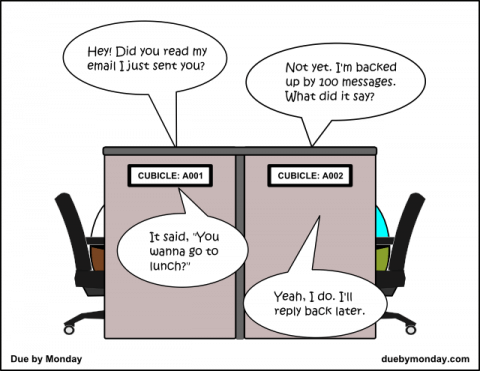By Neal Flesner with excerpts from Jim Eisenhart’s project success guide, Turning the Problem Construction Project into Extraordinary Success.
While many of us have mastered the art of emailing, texting, tweeting, Facebook Messenger and other electronic written communication, verbal communication is still the best way to effectively communicate on a construction project.
A form of digital communication we try to discourage, especially when facilitating problem projects, is email. Although email is trackable and can deliver a message to a team member quickly, it’s not appropriate for all types of messages, it may be overlooked, and it can be easily misinterpreted.
We’ve found that email wastes at least 60% of your time and the time of your fellow team members. Do emails or letters ever solve problems or create opportunities for success? Rarely. Are emails often misinterpreted by those who read them? Yes!
To improve project teamwork, we tell our project teams during the communication protocol part of our Partnering kick-off meetings: “When you can meet, don’t call. When you can call, don’t email.”
With many online meeting options today using desktop or mobile devices, there is no reason to substitute email for talking directly to one another. Nevertheless, if you can meet in person, that’s always the most personable and best option.
If you want to improve communication on your project, suggest to your project team that, from this point forward, team members will exchange zero email communication except to communicate facts or data. If necessary, mutually, and verbally agree if it’s useful to have a confirming email of your important conversations.
Here’s how it works:
- If any team member receives an email from a teammate that should have been discussed first, he or she should immediately call the teammate back and suggest having a conversation.
- If necessary, visit the site jointly and verbally agree or disagree on the circumstances.
- On international teams and even on domestic teams, supplement your conversation with drawings and pictures if it adds clarity to the conversation.
- If you need to address an issue, do it directly one-on-one. Address the process rather than blaming the individual(s). For example, you might say, “Jack I’m concerned that this submittal package is going to be late unless we expedite it. Can we get a team together before the end of the week to talk about it?
Here are some additional guidelines on how high-performing teams communicate:
- Solve the issue verbally or, better yet, face to face and follow the communication protocol suggested above.
- Avoid surprises, but if a surprise arises, immediately discuss it with your partner.
- Avoid whining or complaining. Instead, make requests to meet or resolve the problem.
- Be inclusive. Bring those who can contribute to a solution into the conversation.
- Enter the conversation with recommended solutions.
- Seek mutual understanding of the situation or of what happened without case building or blame. Solve the issue first, as a team, and then deal with accountability for what happened if necessary. Acknowledge what you do not know.
We have witnessed challenging projects improve by at least two points on our 10-point partnering teamwork scale just by adopting and adhering to the communication protocol above.


1 Comment
I couldn’t agree more Neal. At Imajion, we strive to streamline communication by adding the option of getting answers to time sensitive job site questions answered by the right subject matter experts. As a construction consultant, I imagine that you often are called to a site for critical questions. Our solution allows you to give those answers more often and faster. Check out our website for more details.